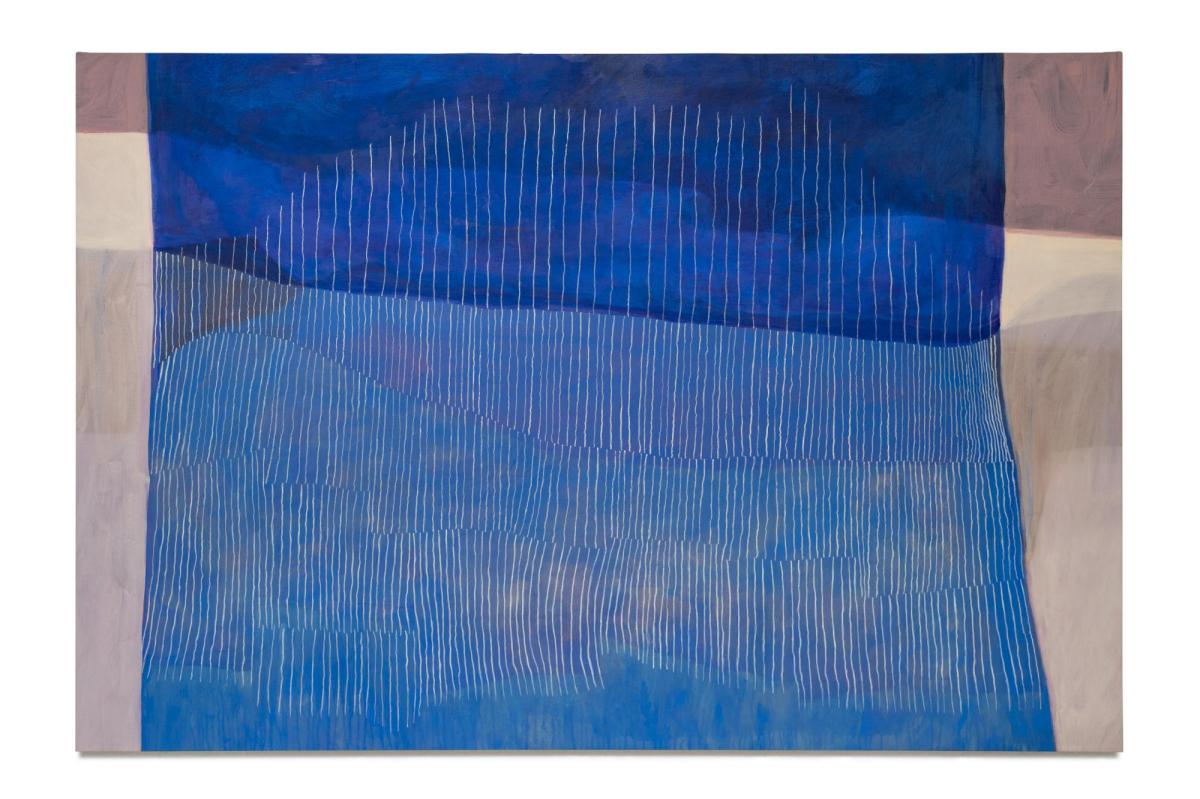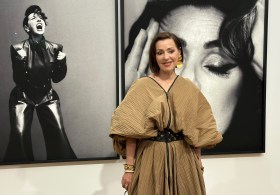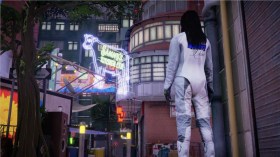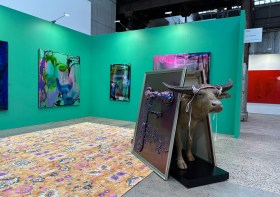A View from the Edge – Living Waters is Paula Irene Payne’s joint exhibition alongside the Art Gallery of New South Wales and Brett Whiteley Studio’s touring showcase Brett Whiteley: Inside the Studio. A rare opportunity to glimpse Whiteley’s studio methods, Inside the Studio traces Whiteley’s enduring fascination with the colour blue, featuring the iconic deep ultramarine The balcony 2 (1975) and Self portrait in the studio (1976), lesser-known blue ink calligraphic drawings and blue-and-white ware.
Partly an homage to the artist who influenced her early career, Payne, presents a compelling selection of artworks that further the pervading blue chromatics.
Spanning three decades, Payne’s artistic practice reflects concerns of the environmental. It raises awareness of climate change, violent and dramatic weather events, sustainability, resource extraction and endangered species. Through mixed painting techniques, architectural and technical drawings, gestural mark making, aeronautical or naval charts and cartographic details, Payne captures natural histories and narratives of the sea and country.
A View from the edge – Living Waters investigates the notion of navigable water bodies and the way in which they inform connections between individuals. It focuses on waterways, wetlands and their processes. The works range from abstract depictions of water movements to semi-abstract and graphic approaches of littoral and intertidal zones with beguiling strips of land, and silts and sediments carried by the tides.
Entering the foyer viewers will encounter The Pause (2022) on the far wall of Gallery One. It represents a fictitious seascape in warm and cool blue hues. Of wide scale, it is both commanding and soothing. Gently bordered by earthy tints, the blue field of scumbled paint captures the changing nature of water and its adaptation to surroundings.
Repetitive whitely patterns of fine linear marks traverse the canvas in swathes. Through manipulation of different layers of translucent and opaque colour, Payne creates a depth beyond the surface. The laboriously applied vertical lines convey tensions of unresolved chronologies. They resemble the tally marks used to inscribe units of time. But Payne doesn’t include horizontal lines running across clusters to complete her tracing of days. In the absence of an ultimate record of the passing of time, The Pause becomes an archive of uncertainties.
On the right side, Algie Bloom (2024) and The Farm (2024), two more large-scaled canvases, sustain the immersive viewing experience. The human figure continues to be visually absent from the scenery, but nevertheless leaves an impression upon it. Blanched iterative motifs and geometric shapes tellingly overlay the colour fields, registering the human impact on the marine realm.
Algie Bloom tackles the ecological effects of algae. A rising temperatures and pollution implication, algal blooms prevent sunlight transmission and, consequently, oxygen formation. Smooth, dark expanses of colour are anxious entry points that depict the underwater “dead zones” where sea life cannot survive. Green and blue tones further delineate space and shadow within the image. With the dripping and pouring of paint, Payne articulates linked emotions of loss and grief.
An investigative approach to salmon farming off the coast of Tasmania, The Farm incites the viewer to reflect upon their role in environmental protection. It implies visual fragility of the water’s edge with seamlessly weaving hues of blue and green. The fusing of brief, expressive linear and circular marks communicate and question change.
Maritime life is also examined in Living Waters – Navigating the Tasman Sea (2023), which features the murky edges of the Tasman Island’s coast with their giant dolerite sea columns. In contrast to The Farm, the diptych seizes the richness of natural sea life between the tides. With a scattering of gestural paint, Payne arrests the unruly character of the Tasman Sea. Adding up intricate, transparent linear renderings, she forges a sense of organic depth.
Payne engages physically with her artworks. She combines traditional easel painting with techniques of poising the skins on the ground, continuously rotating the canvases from vertical planes to flat ones. Her artistic choice is ergonomically challenging, implying an innate response of the manoeuvring body. Constrictions of the flesh are carried by brush strokes and the interplay of fluid and opaque layers.
Yet Payne works with full agency and manipulates perspectives and angles. She spatialises the medium of painting, “tipping” elements of the landscapes towards the audience and enmeshing it in the process of looking. Almost vertiginous, the Sink Hole (2024) escapes the ridged confines of linear standpoint and furthers the immersive viewing event.
Read: Exhibition review: Emerging Artist Award 2024, fortyfivedownstairs
In A View from the Edge – Living Waters, Payne positions the audience at the centre of the paintings. The act of seeing is an active experience and a locus of ethical interrogation.
Paula Irene Payne: A View from the Edge – Living Waters will be on display from 20 July to 8 September 2024 at Logan Art Gallery, Queensland.
Brett Whiteley: Inside the Studio will be on display from 20 July to 8 September 2024 at Logan Art Gallery.





